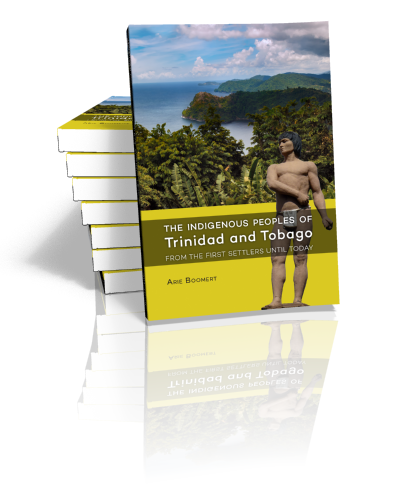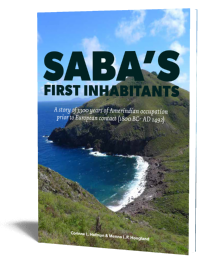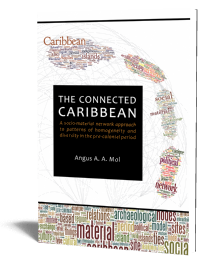The indigenous peoples of Trinidad and Tobago from the first settlers until today
Arie Boomert | 2016

The indigenous peoples of Trinidad and Tobago from the first settlers until today
Arie Boomert | 2016
Paperback ISBN: 9789088903533 | Imprint: Sidestone Press | Format: 182x257mm | 214 pp. | Language: English | 20 illus. (bw) | 40 illus. (fc) | Keywords: Caribbean archaeology, Caribbean history, ethnohistory, Amerindians, linguistics, Ancient Americas, pre-Columbian | download cover
Read online or downloaded 11147 times
-
Digital & Online access
This is a full Open Access publication, click below to buy in print, browse, or download for free.
-
Buy via Sidestone (EU & UK)
-
Buy via our Distributors (WORLD)
For non-EU or UK destinations you can buy our books via our international distributors. Although prices may vary this will ensure speedy delivery and reduction in shipping costs or import tax. But you can also order with us directly via the module above.
UK international distributor
USA international distributor
-
Bookinfo
Paperback ISBN: 9789088903533 | Imprint: Sidestone Press | Format: 182x257mm | 214 pp. | Language: English | 20 illus. (bw) | 40 illus. (fc) | Keywords: Caribbean archaeology, Caribbean history, ethnohistory, Amerindians, linguistics, Ancient Americas, pre-Columbian | download cover
Read online or downloaded 11147 times

We will plant a tree for each order containing a paperback or hardback book via OneTreePlanted.org.
This study relates the vicissitudes of the Amerindian peoples who lived or still inhabit the islands of Trinidad and Tobago, from the earliest occupants, ca. 8000 BC, until at present. Using archaeological, ethnohistorical and linguistic data, it discusses the social, political, economic, and religious development of indigenous society through the ages. The Amerindian struggle with European colonization is chronicled in detail, following centuries of independent existence during pre-Columbian times, as well as the survival of the current people of indigenous ancestry in the twin-island republic.
“This book fills a long-standing gap in the history of Trinidad & Tobago, and the southern Caribbean more generally. It provides a clearly written, authoritative account and analysis of the Amerindians (First Peoples) who lived (and still live) in the two islands, from the very earliest human settlement there up to the present. Based on up-to-the-minute scholarship in several disciplines – archaeology, ethnography, history, linguistics – Boomert dispels many myths and misconceptions about these peoples, and carefully traces the complex history of their settlement, in successive waves of migration, in both islands, their interactions with Europeans arriving from 1498, and their “decline” in the post-contact period.”
Dr. Bridget Brereton, Emerita Professor of History, The University of the West Indies, St. Augustine, Trinidad, Republic of Trinidad and Tobago.
“This book is a welcome addition to the literature we are now seeking to inform our work here at the Santa Rosa First Peoples Community, as it brings to light important aspects of our buried history. Of particular interest is the information on the involvement of the Dutch in the struggles of the First Peoples, and the connection with Hierreyma, our great Nepuyo Chieftain. It is an inspiration to those of us who are currently engaged in efforts to secure the rightful place of the First Peoples of this land – Kairi.”
Ricardo Bharath Hernandez, Chief Santa Rosa First Peoples Community, Arima, Trinidad, Republic of Trinidad and Tobago.
1. Introduction
Geographical situation and natural environment
The indigenous peoples of Trinidad and Tobago
Discovery of archaeological sites
2. The first settlers (ca. 8000–300 BC)
The earliest Trinidadians
The first Tobagonians and late Archaic times in Trinidad
3. New immigrants: the first ceramists (ca. 300 BC–AD 650/800)
Saladoid settlement sites in Trinidad and Tobago
Saladoid ceramics and Barrancoid intrusion
Saladoid/Barrancoid subsistence and food processing
Saladoid/Barrancoid population, society and religion
4. Late-prehistoric cultural change (ca. AD 650/800–1498)
Arauquinoid settlement in Trinidad
Troumassoid occupation of Tobago
On the brink of the Historic Age: Mayoid in Trinidad and Cayo (?) in Tobago
5. Amerindian culture and society in Trinidad and Tobago at the time of the encounter and thereafter
Population and settlement patterns
Subsistence and food processing
Social organization and life cycle
Interaction: war and exchange
Religion: cosmology and shamanism
6. The Amerindian–European struggle for Trinidad and Tobago (1498–1592)
The first European?Amerindian encounters in Trinidad and Tobago
Attempts at Spanish settlement in Trinidad and slave raids in Tobago
7. The Spanish-Amerindian frontier in Trinidad (1592–1686)
Spanish settlement and Amerindian reaction
Hierreyma and the great Amerindian rebellion
8. European settlement and Amerindian response in Tobago (1592–ca. 1810)
Slave raids and the first European attempts at settlement
Further Dutch and Courlander ventures
A peaceful interlude: Tobago as a ‘neutral’ island
From marginalization to extinction
9. Mission villages in Spanish Trinidad (1686–1797)
Establishment of Capuchin missions in Spanish Trinidad
Abolition and reinstatement of the missions
Foreign immigration and the development of a plantation economy
10. British colonization and Amerindian persistence in Trinidad (1797–present)
The end of mission times in British Trinidad
Becoming a small segment of a plural society
The present Amerindian community of Trinidad
Epilogue. The Amerindian heritage of Trinidad and Tobago

Dr. Arie Boomert
Arie Boomert (1946) worked as an archaeologist at the Surinaams Museum, Paramaribo, Suriname; Leiden University and the University of Amsterdam, The Netherlands; and the University of the West Indies, St. Augustine, Trinidad. In 2011 he retired as an Assistant Professor and Senior Researcher from the Faculty of Archaeology, Leiden University. At present he is a Honorary Research Fellow at Leiden University and a Curatorial Affiliate in the Division of Anthropology, Peabody Museum of Natural History, Yale University, New Haven, USA.
Abstract:
This study relates the vicissitudes of the Amerindian peoples who lived or still inhabit the islands of Trinidad and Tobago, from the earliest occupants, ca. 8000 BC, until at present. Using archaeological, ethnohistorical and linguistic data, it discusses the social, political, economic, and religious development of indigenous society through the ages. The Amerindian struggle with European colonization is chronicled in detail, following centuries of independent existence during pre-Columbian times, as well as the survival of the current people of indigenous ancestry in the twin-island republic.
“This book fills a long-standing gap in the history of Trinidad & Tobago, and the southern Caribbean more generally. It provides a clearly written, authoritative account and analysis of the Amerindians (First Peoples) who lived (and still live) in the two islands, from the very earliest human settlement there up to the present. Based on up-to-the-minute scholarship in several disciplines – archaeology, ethnography, history, linguistics – Boomert dispels many myths and misconceptions about these peoples, and carefully traces the complex history of their settlement, in successive waves of migration, in both islands, their interactions with Europeans arriving from 1498, and their “decline” in the post-contact period.”
Dr. Bridget Brereton, Emerita Professor of History, The University of the West Indies, St. Augustine, Trinidad, Republic of Trinidad and Tobago.
“This book is a welcome addition to the literature we are now seeking to inform our work here at the Santa Rosa First Peoples Community, as it brings to light important aspects of our buried history. Of particular interest is the information on the involvement of the Dutch in the struggles of the First Peoples, and the connection with Hierreyma, our great Nepuyo Chieftain. It is an inspiration to those of us who are currently engaged in efforts to secure the rightful place of the First Peoples of this land – Kairi.”
Ricardo Bharath Hernandez, Chief Santa Rosa First Peoples Community, Arima, Trinidad, Republic of Trinidad and Tobago.
Contents
1. Introduction
Geographical situation and natural environment
The indigenous peoples of Trinidad and Tobago
Discovery of archaeological sites
2. The first settlers (ca. 8000–300 BC)
The earliest Trinidadians
The first Tobagonians and late Archaic times in Trinidad
3. New immigrants: the first ceramists (ca. 300 BC–AD 650/800)
Saladoid settlement sites in Trinidad and Tobago
Saladoid ceramics and Barrancoid intrusion
Saladoid/Barrancoid subsistence and food processing
Saladoid/Barrancoid population, society and religion
4. Late-prehistoric cultural change (ca. AD 650/800–1498)
Arauquinoid settlement in Trinidad
Troumassoid occupation of Tobago
On the brink of the Historic Age: Mayoid in Trinidad and Cayo (?) in Tobago
5. Amerindian culture and society in Trinidad and Tobago at the time of the encounter and thereafter
Population and settlement patterns
Subsistence and food processing
Social organization and life cycle
Interaction: war and exchange
Religion: cosmology and shamanism
6. The Amerindian–European struggle for Trinidad and Tobago (1498–1592)
The first European?Amerindian encounters in Trinidad and Tobago
Attempts at Spanish settlement in Trinidad and slave raids in Tobago
7. The Spanish-Amerindian frontier in Trinidad (1592–1686)
Spanish settlement and Amerindian reaction
Hierreyma and the great Amerindian rebellion
8. European settlement and Amerindian response in Tobago (1592–ca. 1810)
Slave raids and the first European attempts at settlement
Further Dutch and Courlander ventures
A peaceful interlude: Tobago as a ‘neutral’ island
From marginalization to extinction
9. Mission villages in Spanish Trinidad (1686–1797)
Establishment of Capuchin missions in Spanish Trinidad
Abolition and reinstatement of the missions
Foreign immigration and the development of a plantation economy
10. British colonization and Amerindian persistence in Trinidad (1797–present)
The end of mission times in British Trinidad
Becoming a small segment of a plural society
The present Amerindian community of Trinidad
Epilogue. The Amerindian heritage of Trinidad and Tobago

Dr. Arie Boomert
Arie Boomert (1946) worked as an archaeologist at the Surinaams Museum, Paramaribo, Suriname; Leiden University and the University of Amsterdam, The Netherlands; and the University of the West Indies, St. Augustine, Trinidad. In 2011 he retired as an Assistant Professor and Senior Researcher from the Faculty of Archaeology, Leiden University. At present he is a Honorary Research Fellow at Leiden University and a Curatorial Affiliate in the Division of Anthropology, Peabody Museum of Natural History, Yale University, New Haven, USA.
-
Digital & Online access
This is a full Open Access publication, click below to buy in print, browse, or download for free.
-
Buy via Sidestone (EU & UK)
-
Buy via our Distributors (WORLD)
For non-EU or UK destinations you can buy our books via our international distributors. Although prices may vary this will ensure speedy delivery and reduction in shipping costs or import tax. But you can also order with us directly via the module above.
UK international distributor
USA international distributor
- Browse all books by subject
-
Search all books

We will plant a tree for each order containing a paperback or hardback book via OneTreePlanted.org.
You might also like:
© 2025 Sidestone Press KvK nr. 28114891 Privacy policy Sidestone Newsletter Terms and Conditions (Dutch)








